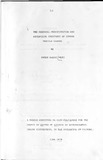| dc.description.abstract | The performance of a stabilization pond is affected by physical and environmental factors among others. Temperature, light, mixing and pH variation are some of the major changing environmental factors. Depth, shape, loading and the nature of waste are some of the physical factors which will affect the organic removal efficiency. Optimum performance can only be achieved if the pond loading meets with the design requirements. A study was carried out on the sources, characteristics and quantities of cotton textile wastes and on the performance of six model ponds, each operating at a difference loading with cotton textile wastes in admixture with a constant volume of domestic waste. The organic removal efficiencies
of the ponds were studied.
The six perspex model ponds were located in a well lighted room. Composite textile waste from a cotton -textile mill and domestic sewage were used for this experiment. A set of six experiments using different textile waste loadings were performed. The samples taken were analysed for COD, DO and pH. Another series of experiments were carried out to precipitate organic load from cotton textile wastes using inorganic coagulants. In a third series of experiments five perspex model ponds were used to study the effects of various direct dyes concentrations on stabilized domestic sewage. Samples taken were analysed for COD, BOD, DO, pH and chlorophyll 'a' concentrations.
From the observations and experimental results obtained, it was found that dissolved oxygen decreases with increased organic loading of the ponds with cotton textile wastes- and that where loadings were low a higher efficiency with regard to organic removal was achieved. From the results of precipitating organic load from cotton textile wastes using inorganic coagulants it was found that’potassium aluminium sulphate v/as more effective than ferric chloride or ferrous sulphate. On the effects of direct dyes on the efficiency of domestic sewage, it v/as found that a direct dye concentration in excess of 10 mg/1 had deleterious effects on algae. | en_US |



